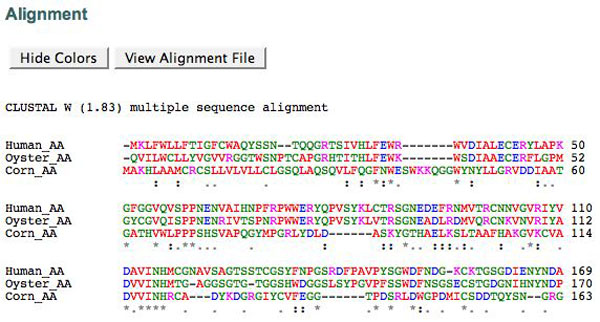The Scores Table shows the number of sequences you submitted, the alignment score and other information. To help understand the alignment score, review the below description from the ClustalW2 site FAQ's:
How are the pairwise alignment scores generated?
A pairwise score is calculated for every pair of sequences that are to be aligned. These scores are presented in a table in the results. Pairwise scores are calculated as the number of identities in the best alignment divided by the number of residues compared (gap positions are excluded).
Returning to your results, you will note that below the table are the results. Scroll down until you see the aligned amino acid sequences. At the bottom of the sequences is a button called “ Show Colours." Click on it. Now your sequences appear in color. To determine what the colors mean, click on “colours” in the left hand column (you’ll probably have to scroll back up toward the top).
Scroll back to your alignment. The first three rows are the aligned amino acid sequences, while the last one is an indication of consensus, or which amino acids are conserved. An alignment will display by default the following symbols denoting the degree of conservation observed in each column. An example of the alignment and the definitions of the consensus symbols are shown below.
Consensus Symbols:
"*" means that the residues or nucleotides in that column are identical in all
sequences in the alignment.
":" means that conserved substitutions have been observed, according to the
COLOUR table below.
"." means that semi-conserved substitutions are observed, i.e., amino acids having similar shape. Conserved means the amino acid is replaced by one having similar characteristics.

Be sure to copy the alignment results to a Notepad file. Look through the entire sequence to look for areas of similarity. How much is there? Can you guess why oyster and human sequences did not appear in the BLAST search with corn alpha-amylase? Compare each pair of sequences to see which ones are most similar. You might need to re-run ClustalW2 with the different pairs to most efficiently determine this. Are there any areas of the sequence that you expect to be more similar between species than others (i.e., the active site)? If you don’t know where the important functional domains are, you should run a search of the literature in PubMed to find out. Simply click on the NCBI icon on the active web page and choose PubMed.